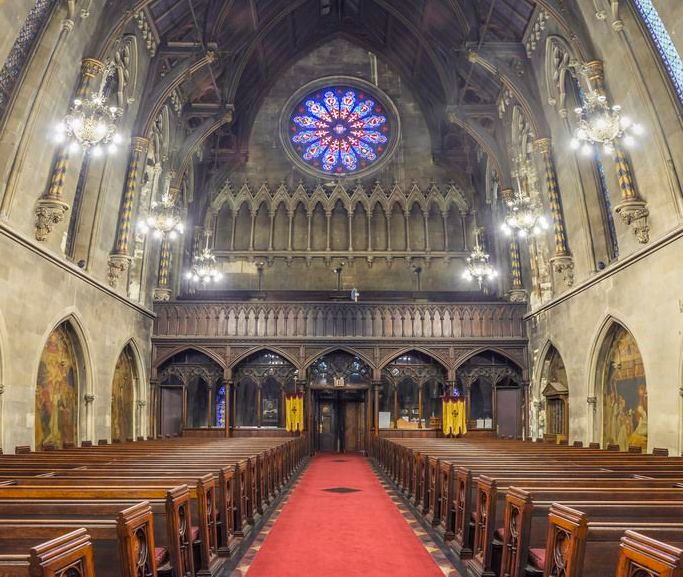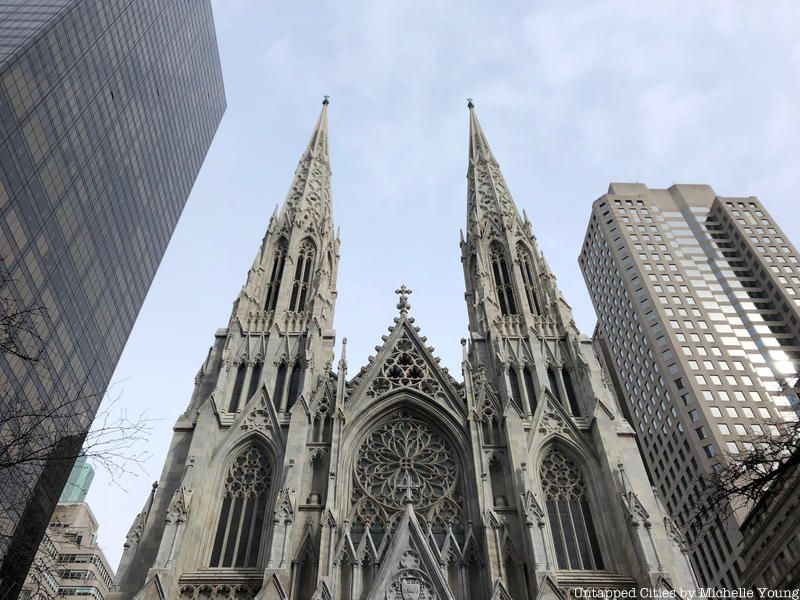A Salvaged Banksy Mural is Now on View in NYC
This unique Banksy mural goes up for auction on May 21st in NYC!


Books are like time capsules that take readers to whatever time and place the stories are set in. Even when there are exaggerations of life in each location, and fictional plots that revolve around wizards and dragons, readers get a glimpse into what life was like in New York City during the ’20s by reading The Great Gatsby; likewise, they can see the city through the eyes of the Beats in On the Road.
New York City has been the setting of countless books throughout time. Those books represent important culture, history, and values of our metropolis and those living within its vibrant walls. Here are five authors who crafted their novels around the culture and influence of New York City during their time.

Photograph of Serbian Orthodox Cathedral of St. Sava by Richard Silver
Edith Wharton was in the news last week as an unknown 1901 play of hers, called Shadow of a Doubt, was discovered in a Texas archive. The writer is most known for her novels like The Age of Innocence and The Custom of the Country, but she wrote a number of undiscovered plays that were never performed.
Wharton lived a high society life in New York City despite her family’s modest wealth; her parents’ pooled money allowed them to live abroad for periods of time, and they raised their daughter in a gilded lifestyle during the late nineteenth century. Wharton didn’t begin her novel writing career until she was almost in her forties and scholars believe she immersed herself into the world of fiction as an escape from her tumultuous marriage with Teddy Wharton. The couple was married in the Serbian Orthodox Cathedral of St. Sava, which was almost completely destroyed in a fire in May of 2016.
Despite being an iconic figure and a staple of New York City’s history, Edith Wharton often remarked about how she hated the city and her disdain for it is most noticeable in her novel, The House of Mirth. Her disinterest in the fake charade of high society is clear through her character Countess Olenska in The Age of Innocence. Olenska is the rebellious character who does as she pleases, defying nineteenth-century etiquette in direct contrast to the typical high society girl, May Welland, who is portrayed as unoriginal carbon cut of the other high-class girls.

The 1920’s classic The Great Gatsby, written by F. Scott Fitzgerald, is less of a love story (as it’s often viewed) and more of a New York City centered horror tale that criticizes the American Dream and its unattainable nature.
F. Scott Fitzgerald was living in New York City when he wrote The Great Gatsby, and much of the book was influenced by his surroundings. Gatsby’s mansion is believed to have been inspired by multiple mansions he visited, including Alva Vanderbilt Belmont’s mansion, the Beacon Towers and Oheka Castle, which was previously a hot spot for Gilded Age parties; it has since been turned into a hotel.
Fitzgerald and his wife Zelda were also married in St. Patrick’s Cathedral and they lived in a suite at the Plaza Hotel until they moved into a rented house in Great Neck which was put up for sale in 2015 for almost four million dollars. Other notable places related to Fitzgerald are Carnegie Hall — featured in The Great Gatsby and home to many jazz performances — and the Museum of the American Gangster, which sheds some light on the Prohibition era, a major influence in Fitzgerald’s novel as well as his personal life as he was an alcoholic.
Today, people throw Great Gatsby-inspired roaring 20’s parties as homage to the decadence and wealth depicted in the novels. Ironically, that’s exactly what Fitzgerald was criticizing in his book. No amount of lavish parties or money made Gatsby happy and none of it was enough to win his true love, Daisy. Gatsby is so caught up in his obsession with a woman he barely knows anymore that he lets his idea of the American dream and the “perfect” girl consume him until it ultimately destroys him.
Also, check out 10 Historic Mansions to Visit on Long Island from the Gold Coast Era.
It’s unsurprising that the Beat Generation — a group of free-thinking people who wanted to be free of normalcy, rejecting the conformity of a nine-to-five job paired with a gray flannel suit — found themselves flocking to artsy places like San Fransisco and Greenwich Villiage. The Beat movement, named by Kerouac and John Clellon Holmes in 1948, was led by authors Jack Kerouac, William S. Burroughs and Allan Ginsberg, who met in New York City at Columbia University. The movement largely revolved around authors, but the idea of breaking free from the norm caught on after Kerouac published On the Road in 1957.
The Beat Generation talked and wrote about the subjects that were taboo in the ’50s like sex, drugs, alcohol, and prostitution. One of the biggest beatnik ideas was the concept of never being tied down to the degree that you couldn’t just pick up and leave if you wanted to. On the Road centers around a group of friends who follow their every whim; they pack bags and spend three years trekking around the country on bus rides. While the characters are frequently on-the-go, Dean Moriarty lives in New York City for the largest period of time when they’re not traveling across the country.
Kerouac’s On the Road was written on a single scroll of paper. Narrator Sal Paradise was meant to emulate Kerouac; Carlo Max as Allen Ginsberg; Old Bull Lee as William S. Burroughs and Dean Moriarty as Neal Cassidy. Kerouac, like the characters in his novel, frequently traveled around the country in a similar fashion, seeking writing inspiration and freedom. Kerouac struggled with setting up the novel and finding a style he liked, but his writer’s block went away after he received a letter from Neal Cassidy illustrating a crazy weekend Cassidy had had. Kerouac later decided on a freeform journalistic style of writing that he dubbed “spontaneous prose.
Kerouac and his beatnik friends spent enough time in New York City to have a long a long list of frequent haunts, many of which no longer exist today. Harmony Diner, the diner that the men are seen entering in the short, silent video, is gone; Cedar Tavern closed in 2008, and Hector’s Cafeteria, where the beats consumed a whole lot of glazed cakes and cream puffs, shut down too long ago to find a date. “Men do love bars and good bars should be loved,” Kerouac wrote in his autobiographical work, Lonesome Traveler. That was a sentiment shared by most of the beats and the few beat haunts still standing today are bars, which would undoubtedly make Kerouac happy if he were alive to see it.

Last week was an exciting week for literature enthusiasts: in addition to Edith Wharton’s lost play discovery, Sylvia Plath experts, who were working on a new book about her novel, The Bell Jar, found two previously undiscovered Plath poems, written on carbon paper in an old journal. The poems are believed to be early works of Plath’s as her style was reportedly unpolished compared to her published poetry.
While Plath never published anything along the lines of a memoir, the parallels between her own experiences in New York City and those of her character, Esther Greenwood from The Bell Jar, are hard to ignore.
Plath’s stint as the guest managing editor of the “Mademoiselle Magazine” mirrors Esther’s internship at her New York City magazine. The people Plath met along the way, like Janet Rafferty, was inspiration for other characters in The Bell Jar. The similarities between Plath’s own life and her novel don’t end there; some specific scenes in her own life — like eating a whole bowl of caviar at the intern lunch — appear in her book as well. With such thinly veiled parallels, it’s not surprising that Sylvia Plath’s real-life depression spiral and suicidal ideation seeped their way into the pages of her novel.
The existing stigma surrounding mental health was much worse in the early to late nineteen hundreds. Most of the early treatments provided to patients were painful, ineffective, and they often caused more discomfort. The history of mental health services in New York City began with insane asylums in the early 1800s. Around 1953, when Plath was in the city, a big mental health policy reform sought to eliminate huge hospitals and unnecessary surgeries, and hospitals began using therapy methods.

Image via Wikimedia Commons, Library of Congress
Catcher in the Rye is one of the most beloved and iconic coming-of-age stories that features a slew of notable New York City landmarks like the American Museum of Natural History, the original Beaux-Arts style Penn Station and Central Park, where the narrator, Holden Caulfield, frequently wonders about where the ducks go in winter. Readers unfamiliar with New York City wouldn’t be able to separate actual city sites with places like the fictional Edmont Hotel where Holden meets the prostitute Sunny. Out of all of the hotels mentioned in the book that actually existed, Seton Hotel is the only one that remains.
As the book set in the 1940s, it’s interesting to take note of what stands as timeless material and what doesn’t. While current New Yorkers haven’t found themselves at a pay phone in a good number of years, people can still readily take cabs even though apps like Uber and Lyft have begun to dominate the scene. The Biltmore Hotel may have been replaced by a Bank of America, but New Yorkers can still visit Central Park’s pond to contemplate where ducks go when the water freezes, and hang out in the Wicker Bar in the Seton Hotel. With a city so vibrant and cultured like New York City, change happens rapidly and nothing illustrates that quite like a novel set in a previous time period.
Join us for our next tour of the Remnants of Penn Station:
Tour of the Remnants of Penn Station
Next, check out By the Decade, 11 Great Fiction Books Set in NYC 1900s to 2000s and 17 Gilded Age Mansions of Millionaire Row on NYC’s 5th Avenue. Get in touch with the author at LitByLiterature.
Subscribe to our newsletter